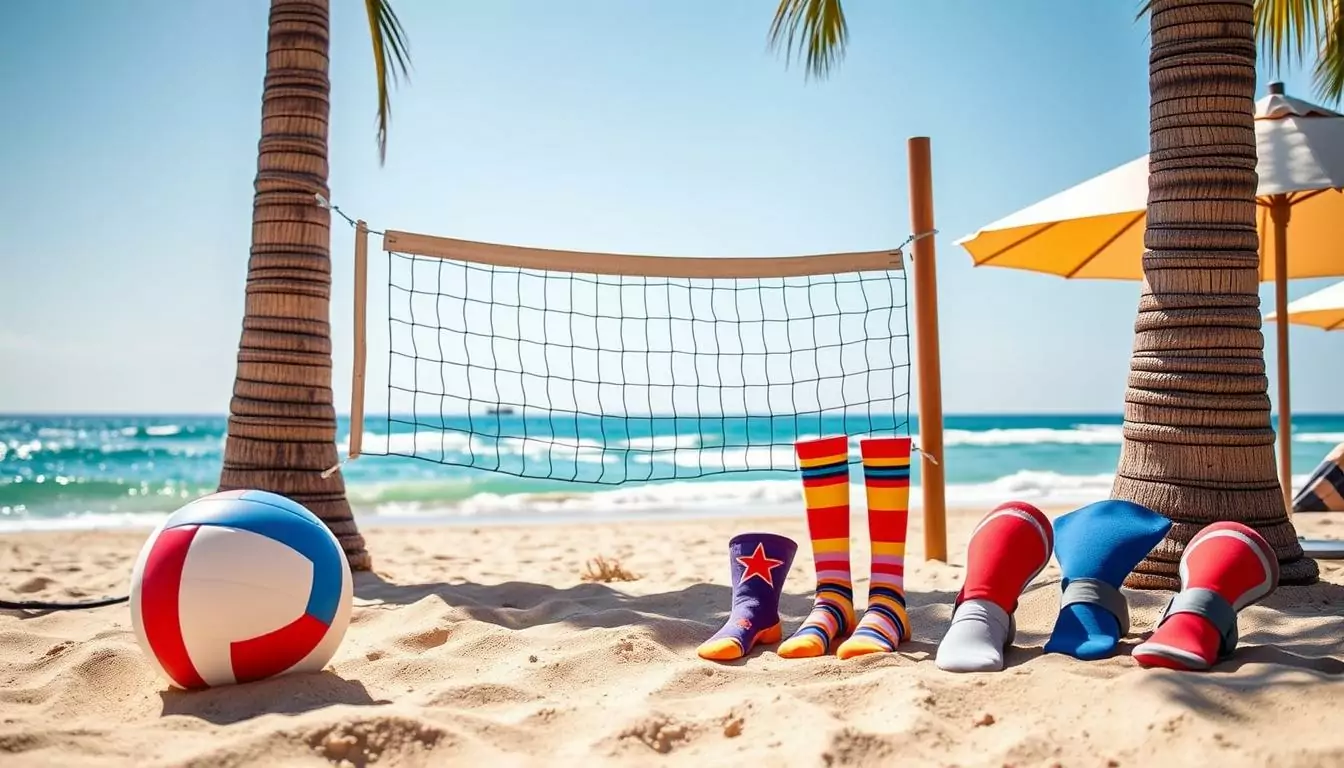Did you know that top brands like Wilson, Mikasa, and Spalding lead the beach volleyball market? As the weather warms up, it’s time to get ready for exciting matches on the sand. Whether you’re an experienced player or new to the game, the right gear is key to success. In this guide, we’ll look at the essential beach volleyball equipment to help you excel on the court.
We’ll cover everything from water-resistant sunscreens with SPF 30 or higher to quick-drying clothes like polyester or nylon. I’ll also talk about the importance of staying hydrated and using sand-free towels from brands like Dock & Bay and Tesalate.
Protecting your eyes from glare and UV rays is vital, so I’ll suggest the best protective eyewear. Remember to bring a hat or visor, a water-resistant watch or timer, and a small, secure bag for your valuables.
Choosing the right beach volleyball clothes is also important. I’ll give tips on finding lightweight, sand-resistant options that let you move freely. With the right gear, you’ll be all set to conquer the sand and win the game.
Key Takeaways:
- Popular beach volleyball brands include Wilson, Mikasa, and Spalding.
- Water-resistant and broad-spectrum sunscreens with an SPF of 30 or higher are recommended.
- Synthetic fibers like polyester or nylon are preferred for beach volleyball apparel.
- Sand-free towels and hydration gear are essential for beach sports enthusiasts.
- Protective eyewear with UV protection is critical for beach volleyball players.
Essential Beach Volleyball Gear
The heart of beach volleyball is the ball. Lifestyles Sports has high-quality beach volleyballs for top performance on sand. Look for a ball with a durable, water-resistant cover, a soft touch for precise control, and a vibrant design for visibility in matches.
There’s more to beach volleyball than just the ball. Get comfortable, breathable sand socks to keep your feet cool. These socks come in many colors, so you can show off your style.
Staying hydrated is vital under the sun. Carry a high-quality water bottle that can handle the weather. Choose insulated bottles that stay cool and pick from a variety of colors.
Protect your eyes from the sun’s glare with stylish, durable sunglasses. Brands like Oakley, Roka, and Blenders offer many options to keep you looking good.
Finish your beach volleyball look with a breathable, adjustable visor. These visors come in many colors, letting you match your gear and show off your style.
With the right gear, you’ll be ready to take on the beach volleyball court. You’ll have fun and make memories with friends and teammates.

Choosing the Perfect Beach Volleyball
Choosing the right beach volleyball ball is key for a fun and winning game. The volleyball used in Olympic beach competition weighs between 260 and 280 grams (a bit more than half a pound) and has a circumference of 66 to 68 centimeters (26 to 26 3/4 inches). It’s usually white with another bright color like yellow or blue to stand out on the sand.
Beach volleyballs are bigger, softer, and lighter than indoor ones. This makes them float better and feel less hard when hit. Top brands for durable, water-resistant beach volleyballs include Wilson, Mikasa, and Spalding. Think about weight, size, and court conditions when picking the perfect ball for a smooth game on the sand.
In college beach volleyball, teams have five pairs of players, making ten athletes per team. College tournaments use a dual match format where two colleges play each other in five matches, with each match featuring a pair from each team. Recreational games can have teams of two to six players per side, with doubles (two players) being the most common.
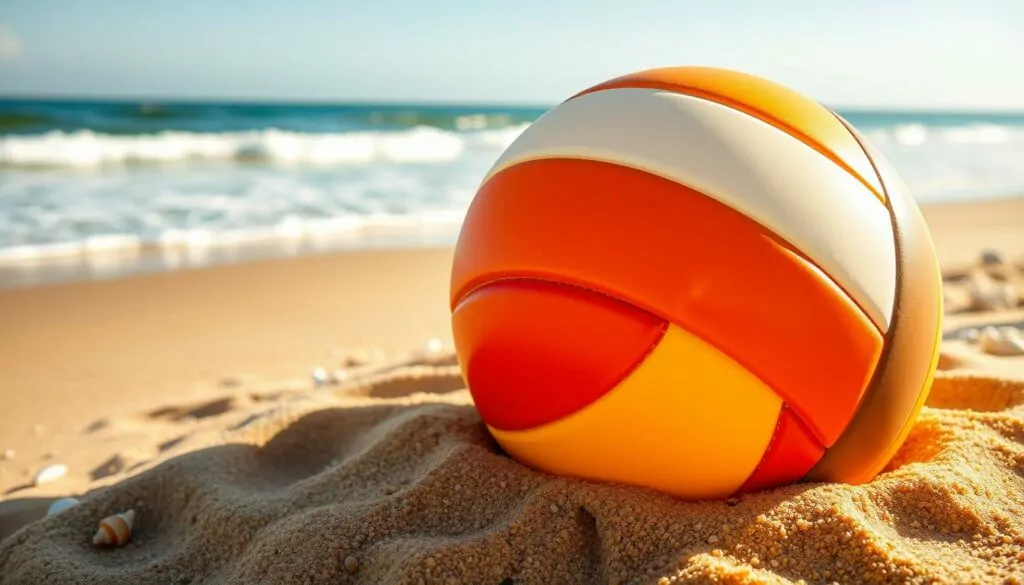
Whether you’re an experienced player or new to the game, the right beach volleyball ball can greatly improve your play. By looking at the ball’s weight, size, and construction, you can have a more comfortable and fun time playing on the sand.
Beach Volleyball Nets and Court Setup
Playing beach volleyball needs the right net and court setup for fun. Whether it’s a temporary or permanent court, knowing the dimensions and equipment is key.
The standard court is 29’6″ by 59′ feet, from the boundary lines. New 2-on-2 courts are 26’3″ by 52’6″. To set up a court, you’ll need 100+ tons of sand, about 12 inches deep. People buy 100-300 tons of sand, depending on the court size and depth.
Choose durable materials like stainless steel or treated wood for the net poles. The poles should be 10.5-16 feet long. The official net is 32 feet long and 39 inches tall. Men’s nets are 7′ 11-5/8″ high, and women’s nets are 7′ 4-1/8″ high.
For a portable option, consider an adjustable or collapsible net set

. One court used 190 tons of sand, costing $10,000 to $12,000.
Knowing about beach volleyball court setup and equipment makes games better. It ensures a well-maintained playing area. This focus on details improves your beach volleyball experience.
Protective Gear for Sand Play
Beach volleyball players should always put safety first. The right beach volleyball gear can improve your game and protect you from injuries. Lifestyles Sports has a variety of protective items. These include beach volleyball knee pads for dives, beach volleyball sunglasses for eye protection, and beach volleyball hats and visors to block the sun.
- Knee pads: They cushion the impact of dives and slides on the sand, making them a must-have.
- Sunglasses: They block glare, helping you see clearly on the court. Beach volleyball sunglasses with UV protection reduce eye strain and boost performance.
- Hats and visors: They shade your eyes from the sun, improving comfort and focus. Beach volleyball hats and visors keep your eyes protected while you play.
Choosing the right protective gear can greatly enhance your beach volleyball experience. It keeps you comfortable, safe, and at your best. Whether you’re a pro or a beginner, your safety is key to enjoying the game fully.
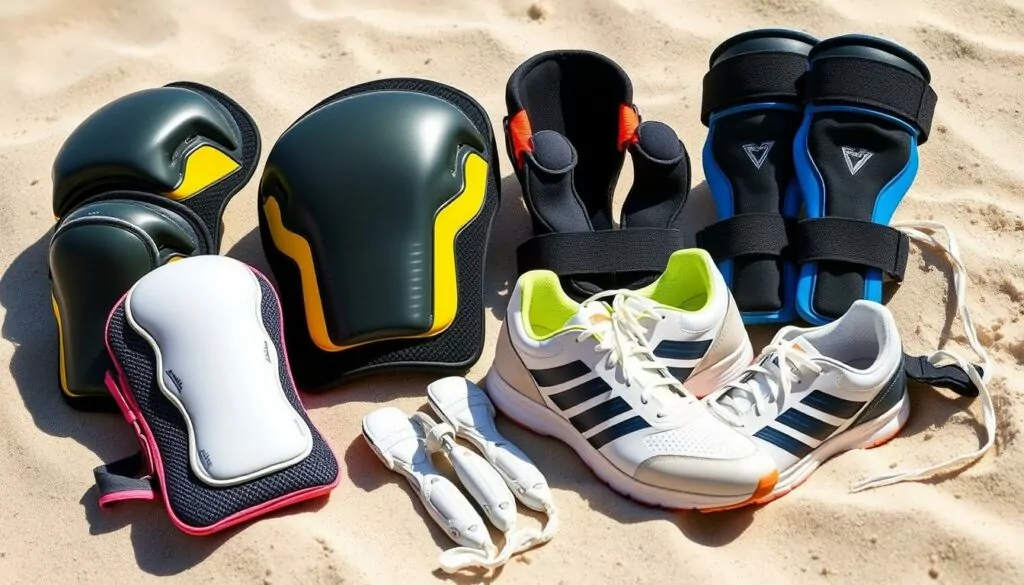
| Product | Features | Benefits |
|---|---|---|
| Elite Sand Socks | – Thicker neoprene sole (3mm) – Better foot and arch protection – More athletic fit |
– Excellent protection against heat, cold, sharp objects, and mud – Suitable for a wide range of beach sports – Comfortable and durable |
| Grip Socks | – Designed for water activities – Provide traction and grip on wet surfaces |
– Ideal for sports like surfing, kayaking, and diving – Help prevent slips and falls in the water |
For both pros and amateurs, the right protective gear is vital. It ensures your safety and comfort, allowing you to focus on improving and enjoying the game.
Protective gear is not just a necessity, but a critical investment in your long-term health and performance as a beach volleyball player.
Beach Volleyball Apparel and Footwear
As a beach volleyball fan, I know how key the right apparel and footwear are. Lifestyles Sports has a variety of performance-enhancing beach volleyball attire. It keeps me cool, comfy, and looking good while I play.
For beach volleyball clothing, I look for lightweight, breathable stuff. Lifestyles Sports’ tank tops and shorts are great for staying dry and moving freely. Their rash guards and compression gear also shield me from the sun and support my muscles.
For beach volleyball footwear, I need shoes that are light, cushioned, and grippy. Lifestyles Sports has options like the ASICS Gel-Rocket, Mizuno Wave Lightning, and Adidas Ligra. They’re made for beach volleyball’s unique needs.
I also use beach volleyball accessories to improve my game. Sunglasses, hats, and visors help me focus. Knee pads protect me on the sand. And a good volleyball bag keeps everything organized.
Lifestyles Sports is a reliable partner for beach volleyball apparel and footwear. They offer top-notch gear that helps me perform at my best.

Accessories to Enhance Your Game
Lifestyles Sports has more than just the basics for beach volleyball. We offer accessories to boost your game and fun on the sand. You’ll find reusable bags for keeping things tidy and portable chargers for your devices. We also have exercise bands for getting ready and staying in top shape.
For sun protection, check out the Adidas Superlite Visor in many colors. Stay hydrated with the YETI Hopper M30 Cooler and Simple Modern Water Bottle.
For comfort on hot sand, try Sand Socks in 9 colors. Music fans will love the Ultimate Ears BOOM 3 Waterproof Speaker.
Protect your skin with Bare Republic Sunscreen Lotion and stay shaded with the Sport-Brella Umbrella. Relax with the Coleman Camping Chair after a game.
These accessories from Lifestyles Sports can elevate your beach volleyball game. Enhance your experience with our carefully chosen must-haves.
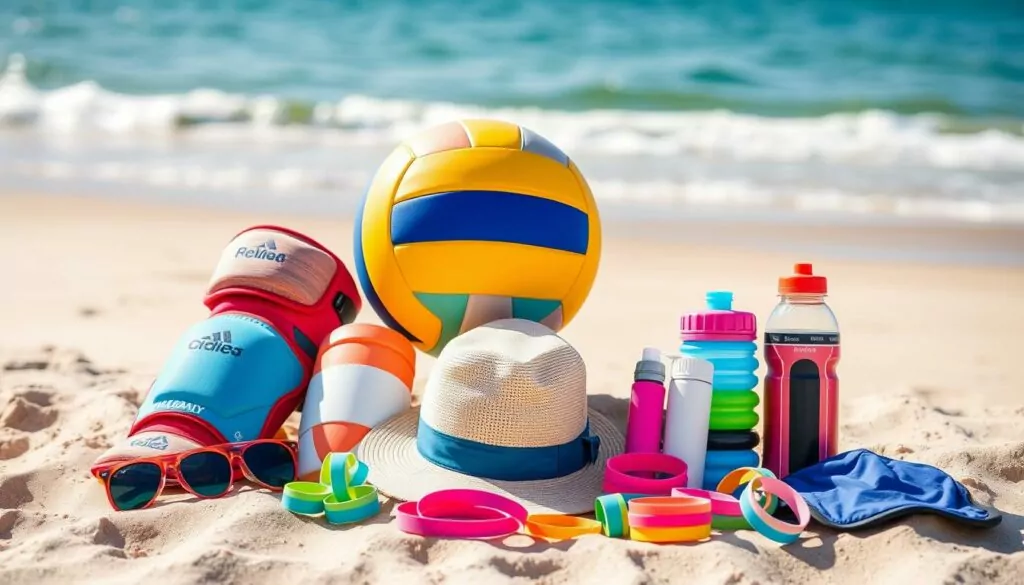
“Roka sunglasses have been my go-to choice for years, and Oakley is a top pick for beach volleyball players, with about 9 out of 10 recommending it. TYR and Blenders have also gained popularity, with Blenders growing thanks to Deion Sanders’ marketing.”
Beach volleyball players often use Perform Better Mini XL Bands for warm-ups. Slunks is known for professional beach volleyball shorts. Laird Apparel, linked to Laird Hamilton, entered the beach volleyball scene in 2022.
TuffSox are the top choice for sand socks, even if they’re hard to put on. Normatec Compression Pants and the Hypervolt Massage Gun are great for recovery. The Peanut Massage Ball is also popular for muscle relaxation.
With many colors to choose from, you can find the perfect accessories to match your style. From 14 colors for the Hydro Flask Water Bottle to 21 options for the Oakley Sutro Lite Sunglasses, there’s a lot to pick from.
At Lifestyles Sports, we aim to give you the best accessories for beach volleyball. Whether you need gear to improve your game or stylish items, we have it all.
Caring for Your Beach Volleyball Equipment
Keeping your beach volleyball gear in good shape is key. This means cleaning and drying the ball and storing the net right. Let’s look at how to take care of your equipment.
Cleaning and Maintaining the Ball
Always clean your beach volleyball after each game. Use a damp cloth or sponge with mild detergent to wipe it down. Make sure to clean the seams and panels well. Then, dry the ball completely to avoid mold or bacteria.
Also, check the ball’s air pressure. Use the pressure recommended by the maker for the best play.
Storing and Transporting the Net
Proper storage of your beach volleyball net is important. Dry the net fully before folding or rolling it. Store it in a cool, dry spot, away from sunlight. This keeps the net from getting damaged.
When taking the net to the beach, use a net bag or case. This protects it from sand and wind.
Protecting Apparel and Accessories
Your beach volleyball clothes and accessories need care too. Choose clothes that dry fast and don’t get damaged by sand and sun. Wash them gently with mild detergent and air-dry to avoid fading or shrinking.
Also, think about getting special beach volleyball shorts or leggings. They’re made to be comfy, durable, and perform well.
By taking these steps, your beach volleyball gear will stay in great shape. Proper care means your gear lasts longer and you have a better playing experience.

Conclusion
Choosing the right beach volleyball equipment can really boost your game and fun. You’ll need things like an insulated water bottle to stay hydrated. Also, don’t forget sunscreen and sunglasses for protection.
Lifestyles Sports is your go-to for top-notch beach volleyball gear. They have everything you need to improve your skills, whether you’re playing seriously or just for fun. Check out their website at www.lifestylessports.com for a wide selection of beach volleyball essentials.
Get ready, hit the sand, and start playing! With the right gear from Lifestyles Sports, you’re set for an exciting beach volleyball season. Finding beach volleyball gear is easy with Lifestyles Sports, your one-stop shop.

The right gear is key for a great beach volleyball experience. Invest in quality, be ready for any weather, and enjoy the game. With Lifestyles Sports, your beach volleyball journey will end on a high note.
“With the right equipment from Lifestyles Sports, you’ll be well-equipped to take your beach volleyball skills to the next level.”
Mastering Beach Volleyball Techniques and Drills
Beach volleyball is an exciting sport that needs special skills and techniques. A strong hitter can really help a team win. To become a top player, you need to learn the basics, like serving, passing, setting, attacking, and defending.

Key Takeaways
- Understand the importance of mastering hitting skills for beach volleyball success
- Learn effective serving techniques for sand play
- Develop proficiency in passing and setting on the beach
- Explore attacking strategies to dominate the court
- Enhance your defensive skills for sand volleyball
This guide will cover many drills and exercises for beach volleyball. You’ll learn about the one-arm swing, the four-step approach, and partner pepper drills. These will improve your technique, power, and accuracy. Whether you’re new or experienced, these techniques will boost your game and help you succeed on the sand.
Fundamental Beach Volleyball Skills
Learning the basic skills of beach volleyball is essential for becoming a skilled player. Skills like serving, passing, setting, and attacking are the building blocks for more complex strategies. They are key to excelling on the court.
Serving: The First Weapon
Serving is the first move in beach volleyball. It’s important to serve well and aim accurately to score points right away. Top-spin serving, like in tennis, hits the ball slightly on top. This makes the ball go faster and more unpredictably towards the opponent.
Passing and Setting: The Pass-Set-Spike Sequence
Good passing is vital for setting up strong attacks. When bump setting, lift the ball up without swinging your arms too much. This keeps your movement controlled. Overhead passing or setting is key in the pass-set-spike sequence, helping to launch a successful attack.
Attacking Options: Mixing It Up
Having different attack options is key to success in beach volleyball. This includes shots off the block, high and low sets, and off-speed shots. A good spike involves four steps, with the last two being jumps, as you speed up to hit the ball. Learning these various attacks will keep your opponents on their toes and give you an advantage.
Defensive Skills: Digging and Blocking
Defensive skills like digging and blocking are just as important. The dig is for defending a ball hit over the net. It requires quick reactions and a low stance to control the ball towards the middle for a counterattack. Blocking involves jumping up at the net, aligning with the attacker, and stretching your arms and hands high to block the attack.
By focusing on these basic skills, you’ll lay a solid foundation for your game. Remember, consistent practice and a desire to learn are essential for mastering these core techniques in this exciting sport.
Serving Techniques for Sand Play
Serving is key in beach volleyball. It sets the rally’s tone. On the sand, a consistent and powerful serve is vital. You also need to adjust the ball’s path and spin for strategic placement.
Beach volleyball servers should aim for the deep corners or middle of the opposing team’s court. This forces players to move from their usual spots, disrupting their game. Serving to deep corners makes passing harder for the receiving player. This keeps the opposing team off balance and increases the chance of an imperfect pass.
Serving down the middle confuses the opposing team. They must quickly decide who will pass, often leading to errors and aces. Professional players know the value of directing serves to specific zones to weaken the opponent’s position. The overhand serve gives players control and allows them to attack with precision.
Beach volleyball is played with 2 players, unlike indoor volleyball’s 6. Players must develop all skills, including passing and defense, to adapt. They should practice basic skills like passing, serving, and setting for at least 1000 reps a day.
Beach volleyball techniques include sand sprints and using legs for bump setting. Players often bump set, even in windy conditions. The forearm pass involves using flat forearms to guide the ball. Improving passing involves learning court positioning and prioritizing passing. Beginners often mimic professional players’ setting styles.
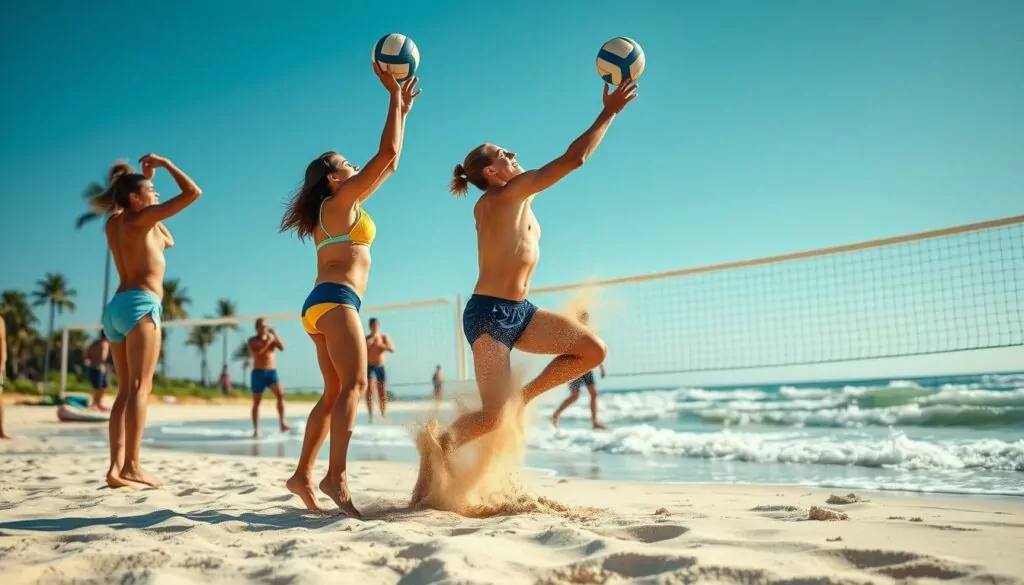
“The serve is the only opportunity a player has to completely control the game. By strategically placing serves, you can force the opposing team to make difficult plays and increase your chances of scoring points.” – John Doe, Professional Beach Volleyball Player
Passing and Setting in Beach Volleyball
Controlling the ball is key in beach volleyball. The uneven surface and wind make passing and setting tough. Learning to read the ball’s path, position your body right, and make precise contacts is vital for success.
Bump setting is a basic yet effective technique. It offers stability and avoids double touches from the ref. Yet, top players prefer hand setting for its precision and control. Misty May-Treanor, a pro, mainly used bump setting. But Melissa Humana-Parades, the 2019 FIVB Setter of the Year, excels in hand setting.
Switching from indoor to beach volleyball requires adjusting setting height and predictability. Sarah Sponcil is known for her hand setting skills and precise sets. Players and coaches vary in how they set up for setting, like facing the antenna or being at a 45-degree angle.
- Good footwork and forward motion are key for a successful set.
- Hand setting is preferred for its control and tempo, says Sarah Sponcil.
- Mastering hand-setting spinning balls can greatly improve set quality.
Setting is the most critical technique in beach volleyball, separating pros from intermediates. Better setting skills can lead to more opportunities, like drills and tournament partnerships. The article details the correct setting form and hand position to avoid mistakes.
For hand setters, ideal footwork involves facing the set location and placing the foot closest to the net forward. A 4-foot set location off the net and 12 feet high is recommended for its effectiveness. Arriving at the setting position at the exact moment the ball drops is also key for smooth setting.
To achieve a smooth touch, the “Hamburger” hand position method is suggested. It involves wrist control, finger relaxation, and optimal thumb action.
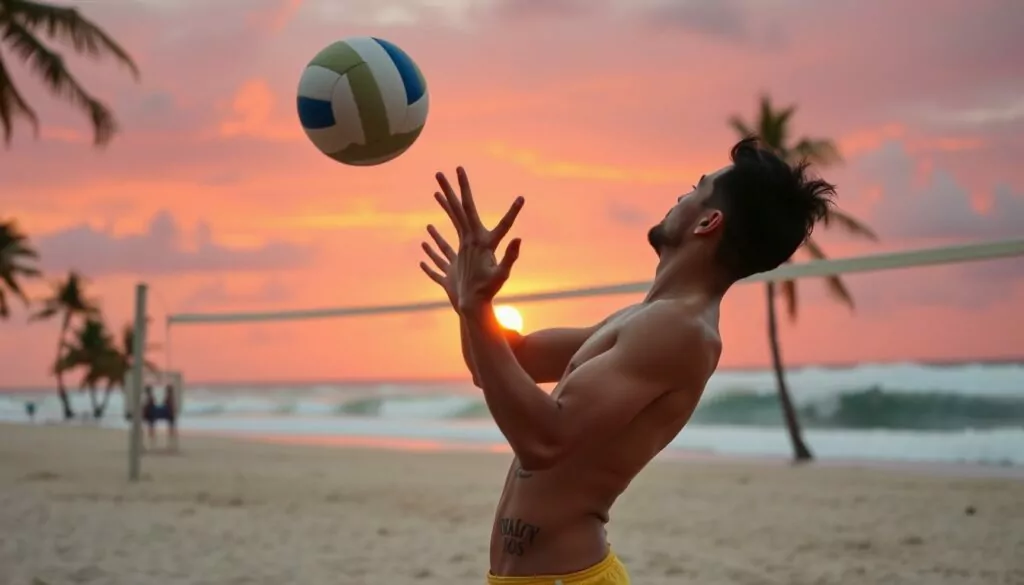
Attacking Strategies on Sand
Beach volleyball attacking is all about power, accuracy, and smart decisions. It’s key to know different spike techniques like cross-court and line shots. These help you outplay your opponents.
Understanding your opponent’s moves is vital. By knowing where they are and their weaknesses, you can surprise them with a well-timed spike.
Good footwork is essential for attacking on sand. The 4-step approach helps transfer energy well. For right-handed hitters, the steps are right, left, right, left. Keeping the ball in line with your body and getting your feet to the ball makes your swing faster.
Hitting the ball at the highest point of your jump is best. It gives you better contact and power. Hitting a bit before the peak can also work well, if your opponent jumps late.
Quickening your arm swing and hitting the ball’s upper half can make your attacks more powerful and accurate. Also, avoid touching the ball with your fingers. It can slow down your hit.
Beach volleyball players can improve by attending camps and clinics. Organizations like Beach Nation, the Beach Education partner of the Junior Volleyball Association and AVCA, offer these opportunities.

Learning various attacking strategies can give you an edge in beach volleyball. It’s about using powerful spikes, reading the defense, and having good footwork and hitting skills. A strong offense is key to doing well in this fast-paced sport.
Defensive Moves for Beach Volleyball
Beach volleyball is all about offense, but defense is just as important. Learning to block, dig, and defend on the floor can turn the game around. These skills help you stop your opponents and gain an advantage.
To start, keep a low stance and be ready to move fast. The crossover step is key for quick changes in direction. Diving and rolling are useful for fast, low hits, but they need lots of practice.
Improving your defense means knowing the court and reading the hitter. Stay low and move quickly to cover the ball.
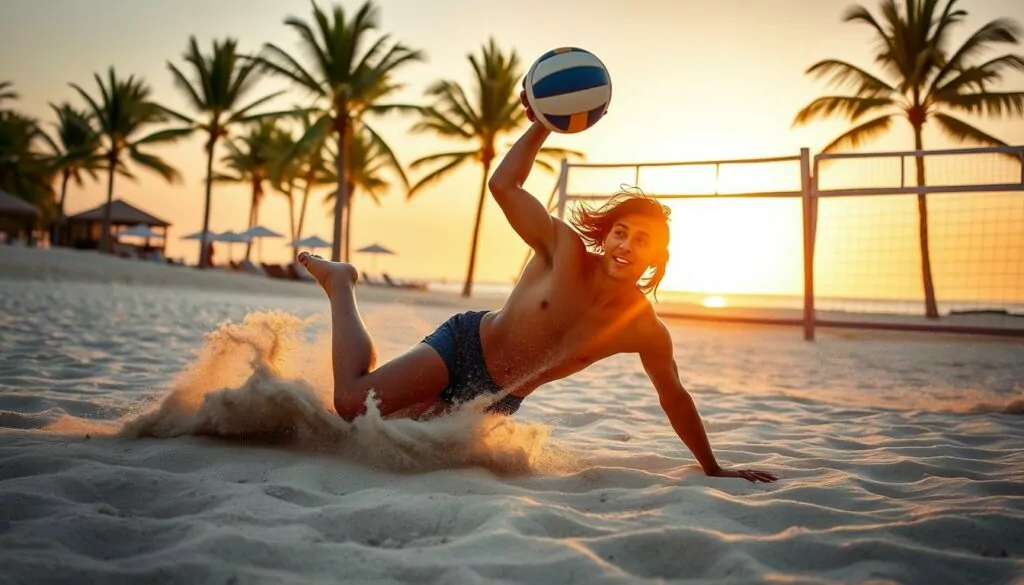
Whether you’re new or experienced, practicing defense is worth it. Training in defensive skills and strategies makes you a better player.
Mastering defense lets you stop opponents and open up chances for your team. With hard work, you can become a defensive star on the beach.
| Defensive Technique | Description | Key Benefits |
|---|---|---|
| Blocking | Positioning your hands and arms at the net to stop the opponent’s attack | Neutralizes the other team’s offensive power, creates scoring opportunities |
| Digging | Using your forearms to control and return a hard-hit ball | Keeps the rally alive, allows your team to counterattack |
| Floor Defense | Sliding, diving, and rolling to retrieve balls hit close to the ground | Saves points, demonstrates commitment to the team |
Beach Volleyball-Specific Drills
To improve your beach volleyball skills, it’s key to use sand-specific drills. These exercises focus on footwork, ball control, and game-like scenarios. They help you get better at the unique demands of the beach volleyball court.
The resource has 36 beach volleyball drills for different skill levels and team sizes. The “Plus Three, Minus Three” drill involves three players and works on serve receive passing. The “4-Way Set” drill is great for improving footwork and set delivery, needing at least three players.
An offensive accuracy drill for four players focuses on spiking to targets. Another drill enhances serving and defensive skills, needing three players.
The “Digging Plus One-Arm Touch” drill improves defensive accuracy and control. The “Two-Zone Beach Volleyball Drill” emphasizes defensive zones, needing two teams.
The drill book has 36 defensive skills drills. Drills range from beginner to advanced, fitting different skill levels. Some drills need at least two players, while others are for larger groups, improving teamwork.
The “Peel & Set” drill works on transitioning from blocking to setting, needing two players or a player and a coach. The “5-10-5 For Speed” drill enhances speed and movement, using sprints between cones.
Materials highlight the importance of proper footwork for defense, focusing on the technical side of beach volleyball. Videos are available to show and explain the drills, adding a visual element to training.
The resource has simpler drills for beginners, like serving practice and easy passing. It also includes fun variations like the “Two-Touch Low Net Front Row Game” and the “Fun High School+ Drill”.
The text emphasizes the importance of defensive skills in beach volleyball, focusing on improving defensive capabilities through drills. Drills aim to enhance reaction times, movement speed, decision-making, and overall defensive performance. Through various drills, players can practice different defensive techniques, becoming more well-rounded defenders.
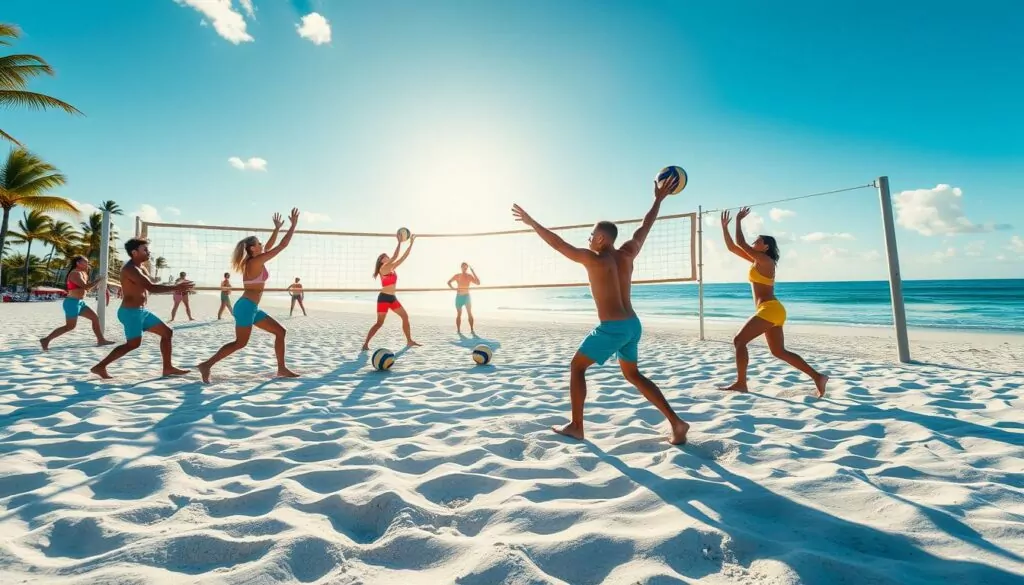
Conditioning Exercises for Sand Athletes
Beach volleyball demands a special conditioning plan. It focuses on explosive moves, agility, and core strength. This helps improve your game and keeps you injury-free.
A good beach volleyball workout should work your whole body. Start with plyometric moves like box jumps and lateral bounds. These build power and explosiveness. Add strength training, like squats and lunges, for lower-body strength.
High-intensity interval training (HIIT) boosts your endurance for beach volleyball. Playing for an hour can burn almost 500 calories, showing the sport’s intense demands.
Cardio is key for lasting through intense rallies. Include running, cycling, or swimming in your routine to increase endurance. Agility drills and plyometric exercises also enhance your court skills.
Strength training is vital for beach volleyball. Focus on upper-body exercises like push-ups and shoulder presses. These improve your spike and block techniques. Core exercises like squats and lunges boost power and stability on the sand.
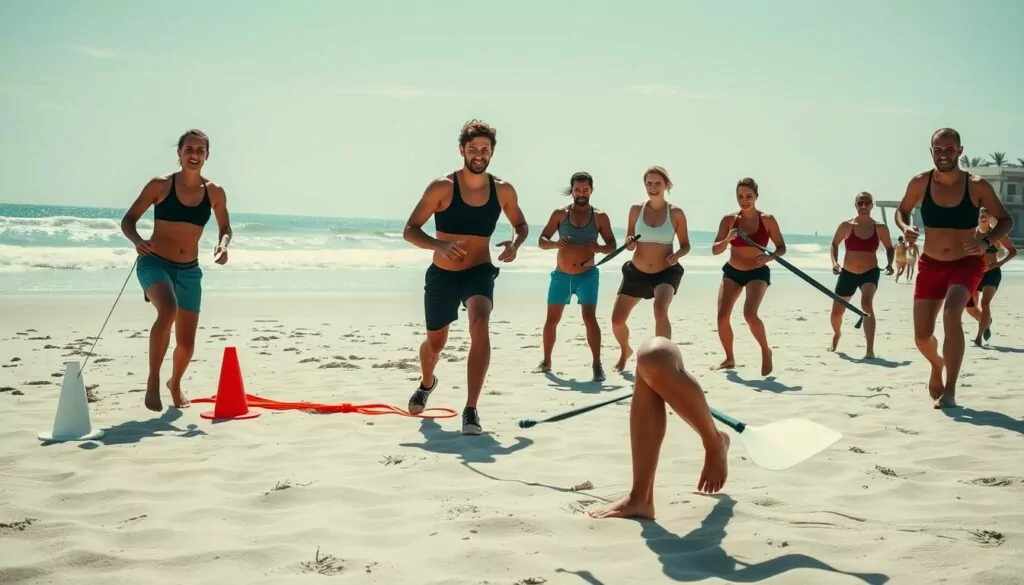
Adding these conditioning exercises to your routine will make you a better beach volleyball player. Focus on building the physical skills that matter most on the sand.
| Exercise | Reps/Duration |
|---|---|
| Push-ups | 10 reps |
| Shoulder Exercises | See “11 Shoulder Exercises for Beach Volleyball in 1 Minute” video |
| Mobility Squats with Overhead & Twisting | 16 reps |
| Knee Hugs Across the Court | Cool-down exercise |
| Running High Knees Across the Court | Cool-down exercise |
Beach volleyball’s physical demands need a customized conditioning plan. By using these exercises and strategies, you’ll excel on the sand.
Conclusion
Mastering beach volleyball takes time and effort, but it’s worth it. With practice and a drive to improve, you can reach new levels. This guide has given you the tools to become a top player on the sand. Beach volleyball is about fun, challenges, and team spirit. So, keep practicing, stay positive, and enjoy the journey!
This guide has everything you need to boost your beach volleyball skills. It’s perfect for beginners and experienced players alike. The most important thing is to love the game, keep trying, and learn from mistakes.
To improve your skills, check out these resources:
- Online tutorials and videos
- Local beach volleyball clubs or leagues
- Skill-building clinics or camps
- Specialized training equipment
- Coaches or mentors for guidance
The journey to becoming a beach volleyball pro is exciting and rewarding. Embrace the sand, sun, and the game’s spirit. You’ll be on your way to becoming a champion.
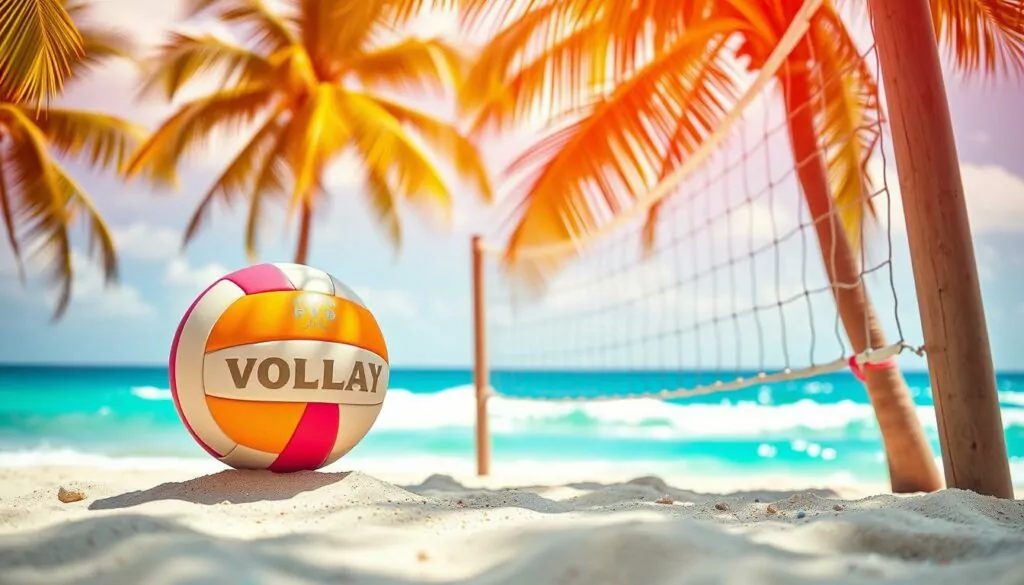
So, what are you waiting for? Hit the sand and start your beach volleyball adventure!
Beach Volleyball vs Indoor Volleyball.Key Differences
Did you know a pro beach volleyball court is 2 meters shorter and 1 meter narrower than an indoor one? This big difference in size is just one thing that makes beach volleyball unique. As a big fan of volleyball, I’m eager to dive into the main differences between beach and indoor volleyball.
Beach and indoor volleyball share the same goal: to send the ball over the net. But, the tactics and physical needs of each can be quite different. The court size, team makeup, scoring, and ball handling rules all vary. These changes bring their own set of challenges and strategies for players.
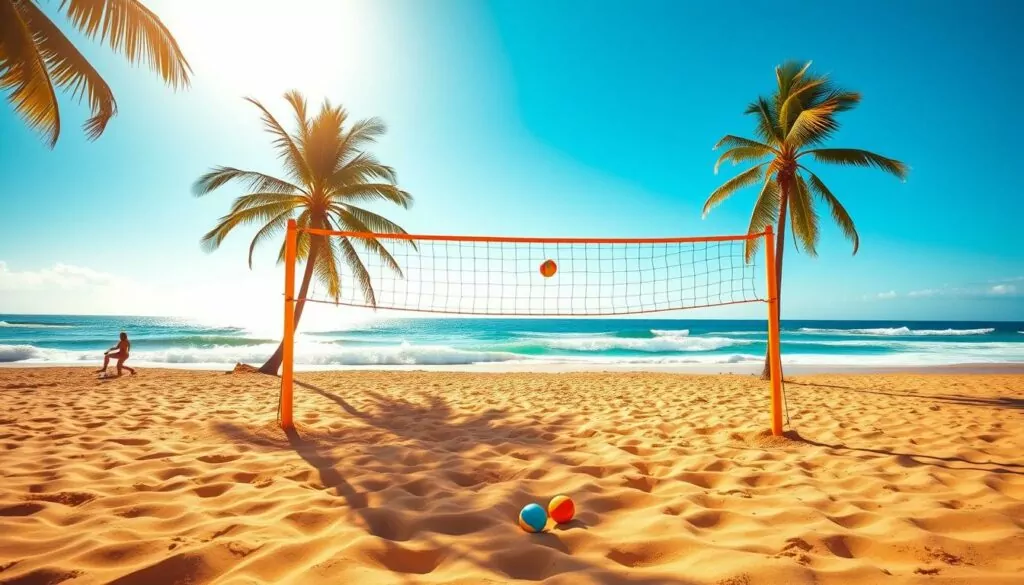
Key Takeaways
- Beach volleyball courts are smaller than indoor courts, measuring 16 meters long and 8 meters wide.
- Beach volleyball is played with 2 players per team, while indoor volleyball has 6 players per side.
- Indoor volleyball sets are played to 25 points, while beach volleyball sets are played to 21 points.
- Double touching is more strictly enforced in beach volleyball compared to indoor volleyball.
- The ball used in beach volleyball is softer and more pliable than the leather or synthetic ball used in indoor volleyball.
Court Size and Playing Surface
Beach volleyball courts are much smaller than indoor ones. They follow FIVB rules and are 16m long by 8m wide. This is 52ft 6in x 26ft 3in. There’s also a free zone of 5m to 6m on each side. Indoor courts, on the other hand, are 18m long by 9m wide. They have a free zone of at least 2m around the court.
Beach volleyball is played on sand, which needs special care. The court base is dug to 3 feet deep. The net is set in concrete, 3 feet deep, for stability. Indoor volleyball, by contrast, is played on surfaces like Sport Court or basketball gyms.
| Court Dimensions | Beach Volleyball | Indoor Volleyball |
|---|---|---|
| Length | 16m (52ft 6in) | 18m (59ft 6in) |
| Width | 8m (26ft 3in) | 9m (29ft 6in) |
| Minimum Free Zone | 5-6m (16ft 5in to 19ft 8in) | 2m (6ft 7in) |
| Net Height (Men) | 2.43m (7’11-5/8″) | 2.43m (8ft) |
| Net Height (Women) | 2.24m (7’4-1/8″) | 2.24m (7’4″) |
The net height also changes between beach and indoor volleyball. Men’s beach volleyball nets are 2.43m high. Women’s nets are 2.24m high. Indoor volleyball nets are the same height as beach volleyball nets for both men and women.
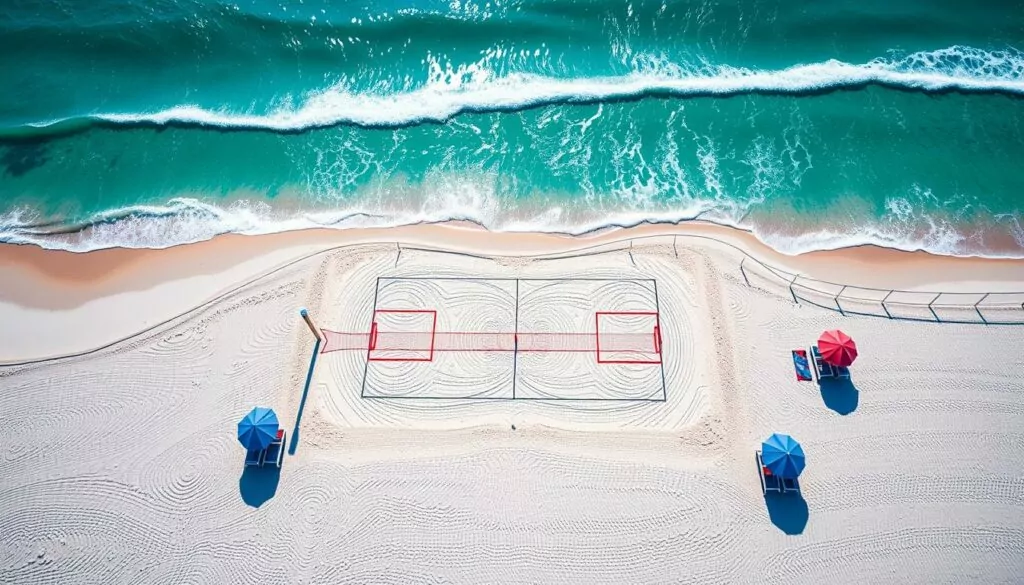
Beach and indoor volleyball have different court sizes and surfaces. This means players must adjust their skills and strategies.
Team Composition and Positions
Beach volleyball and indoor volleyball teams are very different. Beach volleyball teams have two players, each handling all game tasks like serving and attacking. Indoor volleyball teams have six players, with roles like setters and hitters.
Player positions on the court are also different. Beach volleyball has strict rules for player placement on the small sand court. Indoor volleyball allows for more flexibility on the larger court.
Equipment rules in beach volleyball also affect team composition. There are specific gear requirements to ensure fair play and standard equipment for all.
Beach volleyball teams have a team leader or captain. This shows the need for strategic planning and communication between partners.
| Player Positions | Beach Volleyball | Indoor Volleyball |
|---|---|---|
| Setter | Both players share setting responsibilities | Dedicated setter position |
| Attacker | Both players share attacking responsibilities | Dedicated hitter/attacker positions |
| Libero | No dedicated libero position | Specialized defensive player position |
| Server | Serving order dictated by the rules | Flexible serving order |
Beach volleyball rules cover player positions and faults. This ensures teams follow the rules and maintain a strong team dynamic on the sand court.
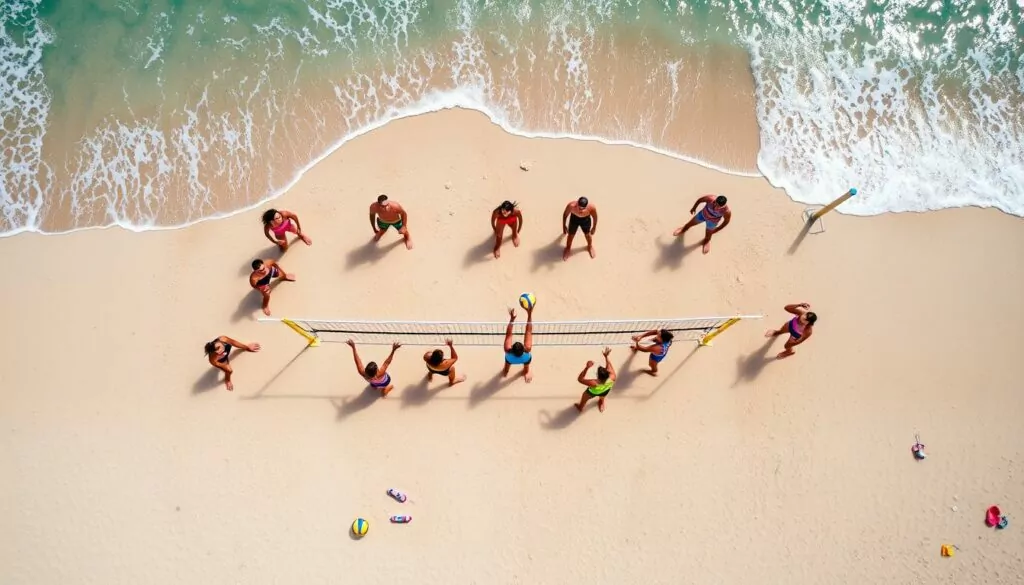
“The two-player version of beach volleyball has become the most widely played version and is the only one contested at an elite level.”
Indoor volleyball teams have a more specialized setup. Each player has a specific role in the six-person lineup. This difference affects the strategies and gameplay in both versions of the sport.
Rules and Scoring Variations
Beach volleyball and indoor volleyball have some key differences. Beach volleyball is played with two players on each side. But, there are variations like coed or reverse coed with different team sizes. For larger teams, the court size grows to 9 meters per side, unlike the standard 8 x 8 meters for two-player teams.
Scoring is another area where they differ. Beach volleyball matches are divided into three games. A team must win two games to claim victory. Each game is won by the first team to reach 21 points, with play continuing until a two-point lead is achieved.
The third game acts as a tiebreaker, played to 15 points with the same two-point advantage rule.
Matches are usually played in a best-of-three set format. Each set is played to 21 points, and a third set is played to 15 points if needed. Rally scoring is used in beach volleyball, allowing either team to score on any serve.
| Rule | Beach Volleyball | Indoor Volleyball |
|---|---|---|
| Team Composition | 2 players per side, with variations for larger teams | 6 players per side |
| Court Size | 8 x 8 meters for 2-player teams, 9 x 9 meters for larger teams | 18 x 9 meters |
| Scoring | Rally scoring, best-of-three sets to 21/15 points | Rally scoring, best-of-five sets to 25 points |
| Substitutions | Not allowed | Unlimited substitutions allowed |
| Time-outs | 4 per match, 30 seconds each | 2 per set, 30 seconds each |
Serving rules require the ball to be hit over the net and land in the opponent’s court. Serves that hit the net and land in play are legal. The receiving team has a maximum of three hits to return the ball over the net, using hands and arms only.
The attacker cannot hit the ball twice in succession. The ball must cross the net and land in the opponent’s court for a valid hit.
Blocks can be executed during an opponent’s attack, but players cannot touch the ball until it is hit. Players switch sides every seven points to counteract sun and wind impacts. During serving, players must avoid stepping on or over the end line for a valid serve.
Beach volleyball does not allow substitutions, but teams can swap courts at specific points in the match. Each team has four timeouts, each lasting 30 seconds, throughout the match. Actions like interfering with opponents under the net or screening them during serving are discouraged. Injuries allow for a five-minute rest period per match.
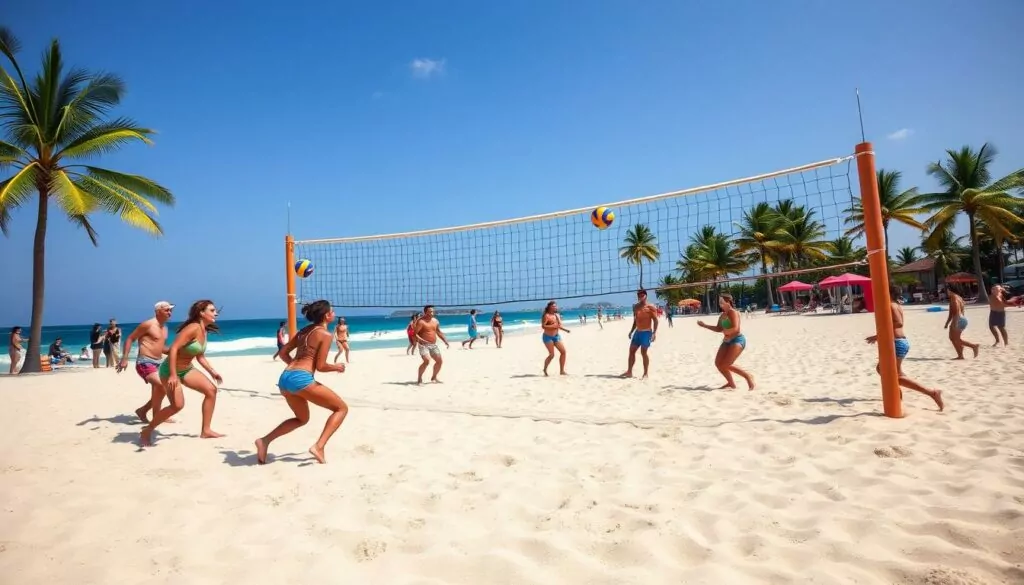
Ball Differences and Handling
Beach volleyball balls are heavier and larger than indoor ones. They weigh between 260 and 280 grams and are 66 to 68 centimeters in circumference. This size and weight, along with the sand, make handling them different.
Indoor volleyball balls are much lighter, weighing 9 to 12 ounces. They are 25 to 27 inches in diameter. Youth indoor balls weigh 9.2 to 9.9 ounces, while adult balls are the same. Their air pressure is between 4.3 to 4.6 psi.
Beach volleyball balls need less air, between 2.5 to 3.2 psi. They also have a rougher texture for outdoor play, unlike indoor balls.
The volleyball design has changed over time. In 2008, indoor balls got an 8-panel design with dimples. This made them better for hand contact and flight. The FIVB’s standardization has made indoor volleyball more consistent.
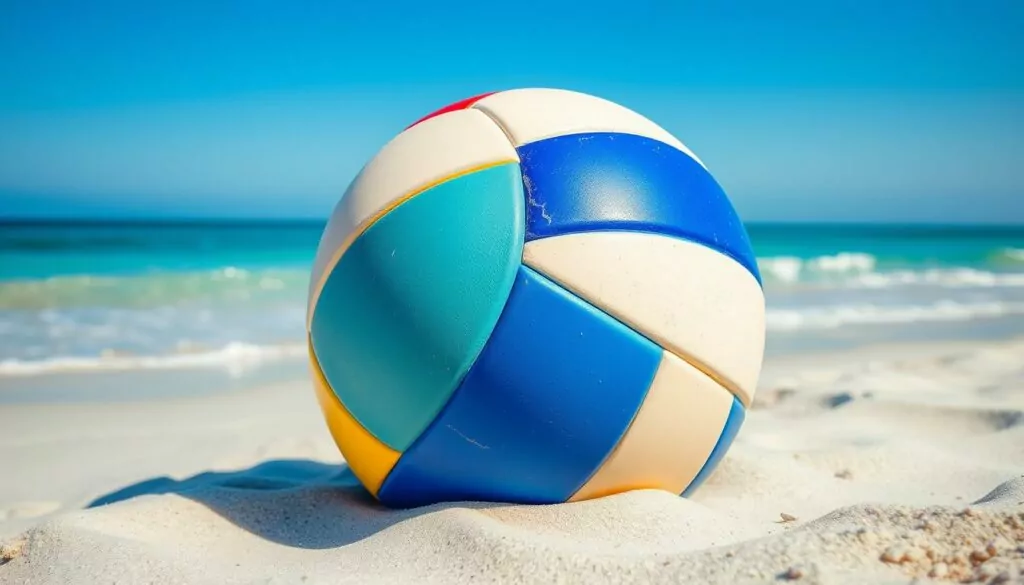
Players need to adapt to these ball differences when moving from indoor to beach volleyball. Knowing the unique features of each ball and how to handle them is key. This knowledge helps athletes do well in both indoor and beach games.
Physical Demands and Fitness Requirements
Beach volleyball is different from indoor volleyball. It needs more explosive moves, agility, and strong core to play on sand. Players also face challenges from the sun, wind, and temperature.
A study with 30 coaches and 30 players showed what’s needed for beach volleyball. High-level players work hard for short times, then rest a lot. This shows the sport’s intense, anaerobic nature. Only one player had a strength and conditioning (S&C) certification, showing the need for special training.
Beach volleyball needs more strength, agility, and endurance than indoor volleyball. A study showed that using resistance bands can lower muscle injuries by 20%. Keeping proper technique is also key, as it lowers injury rates by 25%.
Preventing injuries is vital in beach volleyball. 70% of injuries could be avoided with good warm-ups. Players who rest, recover, and eat well see a 30% drop in fatigue injuries.
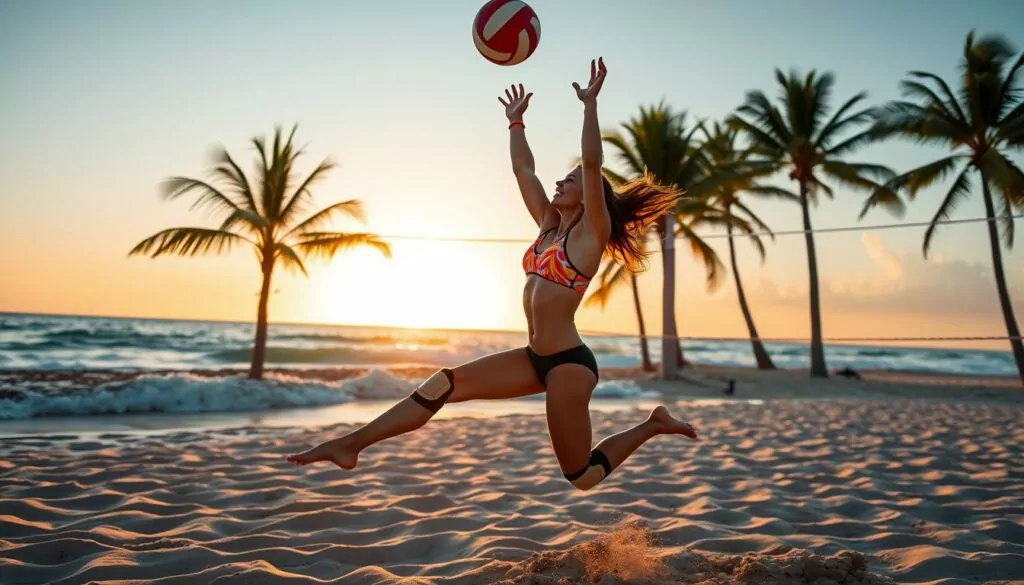
In summary, beach volleyball demands unique skills and a thorough training plan. Knowing the differences between indoor and beach volleyball helps athletes prepare better and stay injury-free.
Tactical Approaches in Each Version
Beach volleyball and indoor volleyball have different playing environments. Beach volleyball tactics focus on serving, making quick decisions, and adjusting to wind and sand. Indoor volleyball, with its larger teams and set plays, is more structured.
In beach volleyball, serving is key. It can really upset the opponent’s game plan. Players must think fast, adapting to the sand and wind. Good footwork and defensive skills are essential for chasing down digs.
Indoor volleyball, by contrast, emphasizes teamwork and making decisions together. Setters and hitters work together on complex plays. Blockers and defenders use a team strategy to defend against attacks. The hardwood floor and larger court allow for different moves and defense compared to sand.
The differences in strategic play between beach and indoor volleyball come from their unique settings. Players and teams need to be flexible, adjusting their tactics for each environment. Whether it’s the open sand or an indoor court, adaptability is key.
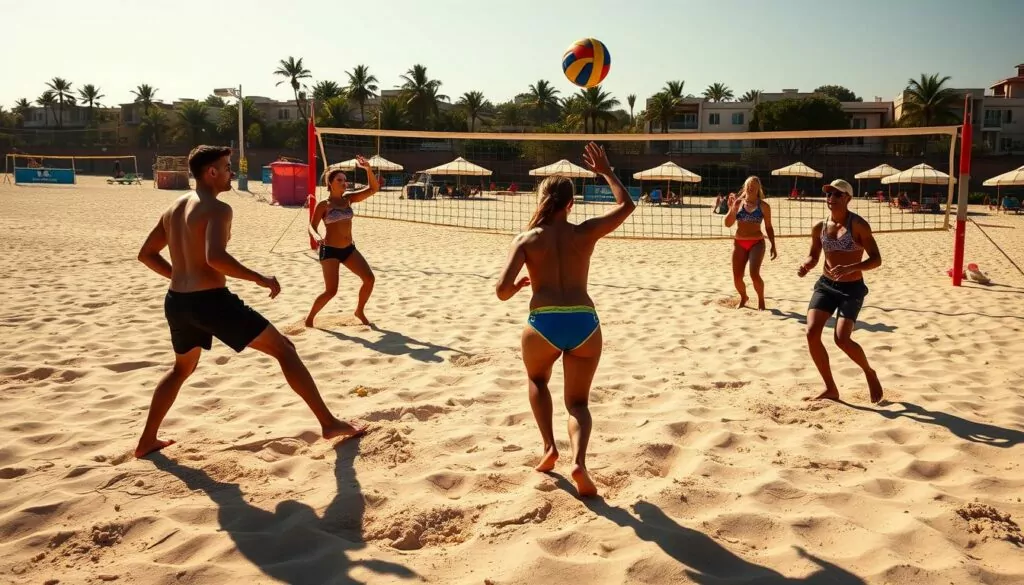
“In all my years of coaching, I always felt that defense determines which team will win.”
Transitioning Between Beach and Indoor Play
Being a versatile volleyball player means you can play both beach and indoor volleyball. You need to know the differences and adapt your skills. Both versions share basic skills, but each has its own unique challenges.
Setting techniques are a big difference. Indoor setters move the ball fast. Beach volleyball uses a smoother, lower approach. Also, beach volleyball allows passing the first ball overhand, unlike indoor play.
Beach volleyball sets are longer and lower, allowing more ball contact. Players must watch out for double contacts, as spinning balls are penalized. Hand setting in beach volleyball is different from indoor volleyball, and it’s optional.
The court and team sizes are different too. Beach volleyball teams are smaller, covering more ground. This means beach players need to be ready for every serve.
Beach volleyball’s uneven surface requires special leg muscles for stability. Indoor players also face unique rules, like not setting a serve with an open hand.
Despite these differences, both versions of volleyball are based on the same skills. By understanding these differences and honing your skills, you can play both beach and indoor volleyball well.
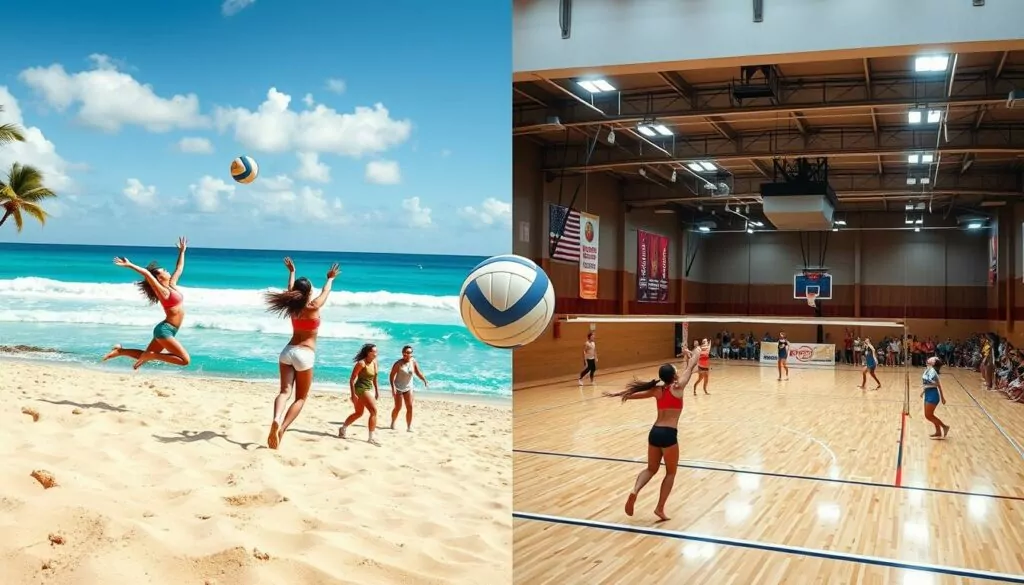
| Aspect | Beach Volleyball | Indoor Volleyball |
|---|---|---|
| Court Size and Players | Smaller court, 2 players per team | Larger court, 6 players per team |
| Offensive Plays | Limited due to fewer players, less jumping | More diverse, with option to choose from multiple attackers |
| Setting Techniques | Smooth, lower contact, optional hand setting | Faster, higher contact, essential hand setting |
| Physical Demands | Requires intense physical and mental preparation | Allows for more specialized roles and rotations |
Knowing the similarities and differences helps players switch between beach and indoor volleyball easily.
“Transitioning between beach and indoor volleyball requires a flexible mindset and specialized training. The nuanced differences in court dynamics, team compositions, and technical approaches demand adaptability from versatile players.”
Conclusion
As we wrap up our look at beach volleyball, it’s clear that it’s different from indoor volleyball. Both offer chances for players to get better and master the game. Beach volleyball needs strength, agility, and endurance, but it also has its own rules and challenges.
Players can grow by understanding the differences between beach and indoor volleyball. Beach volleyball focuses on individual skills and quick thinking. Indoor volleyball, on the other hand, emphasizes teamwork and strategy.
The main point is that knowing both versions well is key. By tackling the unique aspects of each, players can become experts in volleyball. This summary shows why it’s important to be versatile and adapt to each format.
